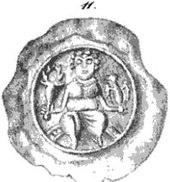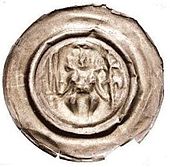Donin's bracteates
Donin bracteates , also called Dohna bracteates or Dohna bracteates , are coins of the burgraves of Dohna . The oldest were minted around 1200 and come from the reign of Heinrich II. Von Dohna (1180–1225), the youngest are from the time of Otto II. Von Dohna (1256–1287). They are the proof of the right to mint coins of the Viscount of Dohna .
The Burgraves of Dohna
The first evidence of a burgrave of Dohna comes from the year 1113. You were active as royal officials and sovereigns in the burgraviate, owned the coin rack from the end of the 12th century and with the Dohnaer Schöppenstuhl the judicial power in feudal and inheritance matters. They were also feudal lords of numerous vassals . At inches of Dresden Elbe bridge they were involved. After the defeat in the Dohna feud from 1385 to 1402, they lost influence and property to the Wettins .
The earlier assumption that the dynasts of the Wettin Lands, including the Burgraves of Dohna, illegally appropriated the right to mint during the political weakening of imperial sovereignty around 1250, is due to the state policy of the Wettins since Henry the Illustrious (1221-1288 ) unthinkable. The Wettins saw the existence of the dynasty as a great obstacle to the realization of their goal, the strengthening of their power. Under no circumstances would they have allowed an imperial shelf such as the right to mint coins to be illegally exercised by imperial ministerials .
Donin's bracteates

The very rare coins of the Burgraves of Dohna are silver bracteates . They are also known as hollow coins, tin coins or tin pennies. In their time, the high medieval regional pfennig period, they were called denarii ( pfennigs ).
The oldest bracteates come from the reign of Burgrave Heinrich II. Von Dohna, son of Heinrich I , the progenitor of the Burgraves of Dohna and were minted around 1200. The youngest are from the time of Burgrave Otto II (1256–1287), son of Heinrich III. from Dohna. Evidence for later coins is missing.
Three types of bracteates from the Donins are known:
- with the seated burgrave (see both images, Erbstein's first discovery)
- with the coat of arms of the Burgraves of Dohna, the crossed stag sticks and the letter H. D. G. B. (Erbstein's second discovery)
- as mentioned before, with the coat of arms of the burgraves, the crossed stag sticks, but without letters.
No other Dohna coins are known.
Erbstein's first discovery
In the eighth fragment of his numismatic fragments in relation to Saxon history (1821), Karl Friedrich Wilhelm Erbstein reported on a Doninian bracteate with a seated burgrave in the coin image, which he discovered first:
"If the so-mighty castle counts of Dohna which so many vassals of nobles or vassals loans subject were, and among others its many large estates also Sämtliche village communities of the present day so-called Leibnitzer religion Office of Dresden , such as the Castel and Burg Weesenstein , the Towns of Rabenau and Döbeln , Königstein , as well as part of the bridge toll in Dresden, etc. s. w. owned, did not [...] have exercised the right to coin ? "
Erbstein was the first to assign the previously undefined bracteate of the Meissnian type with a seated mint master in the coin image who, among other things, holds a deer antler to a burgrave of Dohna:
“The Burgraves of Dohna extensive possessions stretched far up into the mountains and near Dippoldiswalde near Dohna there were rich silver mines even in the oldest times. […] My current bracteat of a burgrave of Dohna is more than Speciesthal's size [a little larger than 40 millimeters in diameter], which is a strange phenomenon for the history of coins in Saxony […]. For the connoisseur, the factory of the same expresses itself very clearly by referring to the old Meißner Land, namely to the times of Margrave Heinrich the Illustrious. Which Münzfürsten or country Assen the old Meissner country but [...] could now antlers so happen on this beautiful and large Bracteaten, allot, than those so mighty castle counts of Dohna that the most deer antler lead in their arms. "
Description of the bracteate (after Erbstein)
"The type of this large bracteate represents a figure sitting on an arch in a house dress with a pearl diadem around his head, who in his right hand has a scepter with a shield and double deer antlers above it, as the coat of arms of the Burgraves of Dohna On the left, however, he holds a shorter scepter on which a resting eagle or falcon sits. "
The bracteate determined by Erbstein was the first discovery of a coin by the Burgraves of Dohna. In his tenth fragment, the scholar added that the bracteate discovered first came from Heinrich II of Dohna or even from Heinrich I, the progenitor of the burgraves of Dohna, who had become hereditary.
Another find
→ See picture above (after Grote)
In 1844, in a small find of Meißner hollow coins, consisting of coins of the Margraves of Meißen , Dietrichs des Belretztten (1197–1221) and Heinrichs the Illustrious as well as the Abbots of Pegau , "two little different copies" of Donin bracteates from the time of Heinrich of the enlightened, namely "from the beginning of this period" that correspond to the original. They were published as a supplement and confirmation of the Erbsteinischen work.
Erbstein's second discovery
The second of Erbstein first discovered bracteate “of a burgrave of Dohna in Meißnischen with inscription from burgrave Hinco or Heinrich III. de Donyn ie Dohna, as it occurs according to documents 1235 and 1242 ”is explained in its tenth fragment from 1828.
"Since it is now very likely that they were the mountain rulers because of the Dippoldis forests, which are so close by and which extended into the possessions of the Burgraves of Dohna , I also rightly conclude," said Erbstein, "that they did that too Münzregal . ”Erbstein's discovery is“ a beautiful, large bracteate which, according to its factory, was [...] quite Meissnian ”. The inscription and the coat of arms testify that it must be a coin of a burgrave of Dohna "namely a burgrave Hinco or Heinrich".
- The image shows the coat of arms of the burgraves with the crossed stag sticks.
- Inscription (after Erbstein): H. D. G. B.
- written out (after Erbstein): "Hinco or Henricus Dei Gratia Burggravius"
- Translation: Henry by the grace of God, burgrave
- written out (after Erbstein): "Hinco or Henricus Dei Gratia Burggravius"
"But who this Heinrich could be", so the scholar, "tells me [...] the coat of arms of the double deer antlers [...]". It is shown on the coin as “how these deer antlers were on a pillar of the Dresden bridge before the French Marshal Davoust destroyed it ; because the burgraves of Dohna enjoyed part of the Dresden bridge toll in earlier times. "
Erbstein was able to prove, among other things, on the basis of the type of coinage, which corresponds to the Meissen bracteates of Henry the Illustrious, who ruled from 1221 to 1288 and the reign of the Burgraves of Dohna, that the bracteate with the inscription and the coat of arms of Burgrave Heinrich III . von Dohna (1239–1256) must be.
KFW Erbstein's “Numismatic Fragments” are still listed in catalogs today as evidence of Dohna bracteates.
Mountain and hut shelf of the Donins
According to Daniel Beck's repertory , the second bracteate confirms that the burgraves of Dohna, whose possessions extended into the Dippoldiswald silver mines, ruled the mountain and coin rack.
However, minters do not necessarily have to have their own silver pits in order to mint coins. The unequivocal evidence of Doninian bracteates does not necessarily mean that the burgraves owned silver mines with certainty and that Dippoldiswalde was one of them.
The similarity with the Meissen bracteates
The similarity between the dynasty and the margraves, including the Doninian bracteates with the Meißnian, was intentional. This knowledge helped Erbstein determine the two types of Donin bracteates with the seated burgrave and with the crossed stag poles. They were supposed to roam unrecognized in foreign economic areas in order to be able to buy it out and probably also not to draw the attention of the margraves striving for power growth.
See also
Saxon coin history # Bracteatenzeit
literature
- Walther Haupt : Sächsische Münzkunde , Deutscher Verlag der Wissenschaft, Berlin 1974
- Friedrich von Schrötter (Ed.): Dictionary of Coin Studies , de Gruyter, Berlin 1970 (reprint of the original edition from 1930)
- Helmut Kahnt: The large lexicon of coins from A to Z , Regenstauf 2005
- Central Technical Committee Numismatics Berlin: Historical Mints on the Territory of the GDR , Part 1, Numismatic Booklet No. 22, Berlin 1986
- Yves Hoffmann: The history of Dippoldiswalde up to the end of the first mining period around 1400 , in work and research reports on Saxon soil monument conservation, Volume 51/52, 2009/2010
- Christine Klecker: How Dohna was lost. Weesenstein Castle Museum, 1991
- Hermann Grote (Hrsg.): Blätter für Münzkunde , Hanoverian Numismatic Journal. Fourth volume, Leipzig 1844
- Henning / Müller / Wintermann: Weesenstein. 700 years of castle history. Dresden 1995
- Karl Friedrich Wilhelm Erbstein : Numismatic fragments in relation to Saxon history . Volume 1-3. Dresden 1816–1828
Individual evidence
- ↑ Christine Klecker: How Dohna went lost (1991), p. 22, reference 71
- ↑ Work and research reports on the Saxon ground monument preservation Volume 51/52, 2009/2010: Yves Hoffmann: Die Geschichte von Dippoldiswalde ... , p. 395
- ↑ Walther Haupt: Sächsische Münzkunde (1974), p. 44
- ↑ Christine Klecker: How Dohna went lost (1991), p. 22: no evidence available
- ^ Karl Friedrich Wilhelm Erbstein: Numismatic fragments in relation to Saxon history , VIII. Fragment (1821), cover picture of the second issue, image 10
- ↑ Hermann Grote (Ed.): Blätter für Münzkunde , fourth volume, (1844), plate II. Fig. 11
- ↑ Christine Klecker: How Dohna went lost (1991), p. 16: after Münzkabinett Dresden
- ^ Karl Friedrich Wilhelm Erbstein: Numismatic fragments in relation to Saxon history , 10th fragment (1828), p. 24/43
- ^ Acsearch: Dohna, Burggrafschaft, Heinrich III. around 1235-1242 bracteate. Weight 0.67 g, deer antlers (actually crossed deer poles), inscription: HDGB, Erbstein, Numismtische Bruchstücke, 9. –11. Fragments, pp. 24–43, Tab. II, No. 4, Thieme -, Schwinkowski - (cf. 1026, 1027), Berger -, Bonhoff collection -, Krug collection -. (The line behind the catalog information should indicate that the bracteate does not appear there.)
- ↑ Christine Klecker: How Dohna went missing (1991), p. 17: after Münzkabinett Dresden
- ^ Report from 1829 to the members of the German Society for Research into the Fatherland Language and Antiquities ..., Leipzig 1829: p. 38: No further coins
- ↑ Christine Klecker: How Dohna was lost (1991), p. 22
- ^ Karl Friedrich Wilhelm Erbstein: Numismatic fragments in relation to Saxon history , VIII. Fragment (1821), pp. 60–67
- ^ Karl Friedrich Wilhelm Erbstein: Numismatic fragments in relation to Saxon history , VIII. Fragment (1821), pp. 67-69
- ^ Karl Friedrich Wilhelm Erbstein: Numismatic fragments in relation to Saxon history , VIII. Fragment (1821), pp. 70–71
- ^ Karl Friedrich Wilhelm Erbstein: Numismatic fragments in relation to Saxon history , 10th fragment (1828), p. 35
- ↑ Hermann Grote (Ed.): Blätter für Münzkunde , fourth volume, (1844) p. 27, article by CW Barth
- ^ Karl Friedrich Wilhelm Erbstein: Numismatic fragments in relation to Saxon history , 10th fragment (1828), pp. 24–42
- ↑ acsearch: Heinrich der Erlauchte, Bracteat Meißen
- ↑ Work and research reports on the Saxon ground monument preservation Volume 51/52, 2009/2010: Yves Hoffmann: Die Geschichte von Dippoldiswalde ... , p. 395
- ↑ Walther Haupt: Sächsische Münzkunde (1974) p. 48



